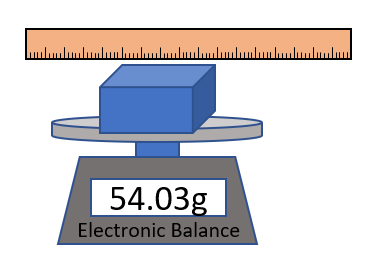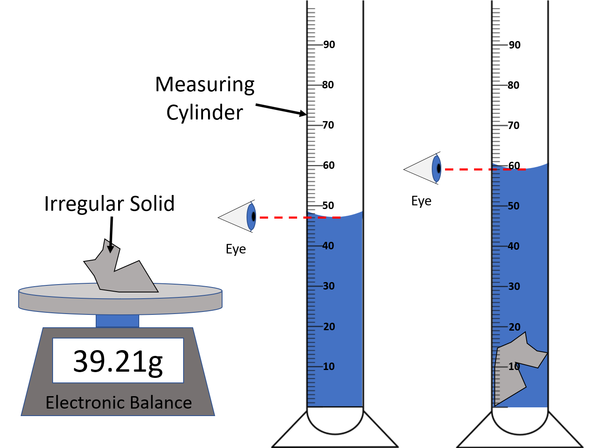Difference between revisions of "GCSE Physics Required Practical: Calculating Densities"
(→Key Stage 4) |
(→Improving Precision) |
||
| (14 intermediate revisions by the same user not shown) | |||
| Line 1: | Line 1: | ||
==Key Stage 4== | ==Key Stage 4== | ||
| + | {{#ev:youtube|https://www.youtube.com/watch?v=lvqu6JAbaKc}} | ||
===Meaning=== | ===Meaning=== | ||
Finding the [[density]] of [[solid]] [[object]]s. | Finding the [[density]] of [[solid]] [[object]]s. | ||
| − | ===Experiment 1: | + | ===Experiment 1: Cuboid=== |
====Method==== | ====Method==== | ||
{| class="wikitable" | {| class="wikitable" | ||
|- | |- | ||
|[[File:RequiredPracticalDensity1.png|center|400px]] | |[[File:RequiredPracticalDensity1.png|center|400px]] | ||
| − | | style="height:20px; width:200px; text-align:center;" |A [[diagram]] of the [[apparatus]] used in an [[experiment]] to find the [[density]] of a | + | | style="height:20px; width:200px; text-align:center;" |A [[diagram]] of the [[apparatus]] used in an [[experiment]] to find the [[density]] of a cuboid. |
|} | |} | ||
| − | #Measure the [[mass]] of the | + | #Measure the [[mass]] of the cuboid using an [[Electronic Balance|electronic balance]] or [[Measuring Scale|measuring scale]]. |
| − | #Measure the length, width and height of the | + | #Measure the length, width and height of the cuboid using a [[ruler]]. |
#Multiply the length, width and height to calculate the [[Volume (Space)|volume]]. | #Multiply the length, width and height to calculate the [[Volume (Space)|volume]]. | ||
| − | #Use the equation <math>\rho = \frac{m}{V}</math> to calculate the [[density]] of the | + | #Use the equation <math>\rho = \frac{m}{V}</math> to calculate the [[density]] of the cuboid. |
====Improving [[Accuracy]]==== | ====Improving [[Accuracy]]==== | ||
: Place the [[Electronic Balance|electronic balance]] on a flat, level surface to get an [[accurate]] reading of the [[mass]]. | : Place the [[Electronic Balance|electronic balance]] on a flat, level surface to get an [[accurate]] reading of the [[mass]]. | ||
| − | |||
| − | |||
| − | |||
| − | |||
| − | |||
===Experiment 1: Irregular Solid=== | ===Experiment 1: Irregular Solid=== | ||
| Line 34: | Line 30: | ||
#Measure the [[mass]] of the [[object]] using an [[Electronic Balance|electronic balance]] or [[Measuring Scale|measuring scale]]. | #Measure the [[mass]] of the [[object]] using an [[Electronic Balance|electronic balance]] or [[Measuring Scale|measuring scale]]. | ||
| − | #Fill a [[Measuring Cylinder|measuring cylinder]] with enough [[water]] to | + | #Fill a [[Measuring Cylinder|measuring cylinder]] with enough [[water]] to submerse the [[object]]. |
#Take a [[reading]] of the [[Volume (Space)|volume]] of [[water]] in the [[Measuring Cylinder]]. | #Take a [[reading]] of the [[Volume (Space)|volume]] of [[water]] in the [[Measuring Cylinder]]. | ||
| − | #Place the [[object]] in the [[Measuring Cylinder]] and ensure it is | + | #Place the [[object]] in the [[Measuring Cylinder]] and ensure it is submersed. |
#Take a [[reading]] of the [[Volume (Space)|volume]] of [[water]] + [[object]] in the [[Measuring Cylinder]]. | #Take a [[reading]] of the [[Volume (Space)|volume]] of [[water]] + [[object]] in the [[Measuring Cylinder]]. | ||
#Subtract the [[Volume (Space)|volume]] of [[water]] from the [[Volume (Space)|volume]] of [[water]] + [[object]] to find the [[Volume (Space)|volume]] of the [[object]]. | #Subtract the [[Volume (Space)|volume]] of [[water]] from the [[Volume (Space)|volume]] of [[water]] + [[object]] to find the [[Volume (Space)|volume]] of the [[object]]. | ||
| Line 44: | Line 40: | ||
: Ensure the [[mass]] is [[measure]]d at the start of the [[experiment]] so that the [[mass]] is [[measure]]d while the [[object]] is dry. | : Ensure the [[mass]] is [[measure]]d at the start of the [[experiment]] so that the [[mass]] is [[measure]]d while the [[object]] is dry. | ||
: Place the [[Electronic Balance|electronic balance]] on a flat, level surface to get an [[accurate]] reading of the [[mass]]. | : Place the [[Electronic Balance|electronic balance]] on a flat, level surface to get an [[accurate]] reading of the [[mass]]. | ||
| − | : Place the [[Measuring Cylinder|measuring cylinder]] on a flat, level surface to get an [[accurate]] reading of the [[Volume (Space)|volume]]. | + | : Place the [[Measuring Cylinder|measuring cylinder]] on a flat, level surface and read it from eye level to get an [[accurate]] reading of the [[Volume (Space)|volume]] of [[water]]. |
| + | : Ensure no [[water]] is spilled to get an accurate measurement for the [[Volume (Space)|volume]] of the [[object]]. | ||
| + | : Ensure the [[object]] is fully submerged to get the correct value for the [[Volume (Space)|volume]] of the [[object]]. | ||
====Improving [[Precision]]==== | ====Improving [[Precision]]==== | ||
| − | : | + | : Ensure no [[water]] is spilled from the [[Measuring Cylinder|measuring cylinder]] so that all repeat readings are the same. |
| + | : Measure the 'dry' [[mass]] of the [[object]] to ensure repeat readings are not affected by [[water]] permeating the [[object]]. | ||
Latest revision as of 09:19, 23 November 2019
Contents
Key Stage 4
Meaning
Finding the density of solid objects.
Experiment 1: Cuboid
Method
| A diagram of the apparatus used in an experiment to find the density of a cuboid. |
- Measure the mass of the cuboid using an electronic balance or measuring scale.
- Measure the length, width and height of the cuboid using a ruler.
- Multiply the length, width and height to calculate the volume.
- Use the equation \(\rho = \frac{m}{V}\) to calculate the density of the cuboid.
Improving Accuracy
- Place the electronic balance on a flat, level surface to get an accurate reading of the mass.
Experiment 1: Irregular Solid
Method
| A diagram of the apparatus used in an experiment to find the density of an irregular solid. |
- Measure the mass of the object using an electronic balance or measuring scale.
- Fill a measuring cylinder with enough water to submerse the object.
- Take a reading of the volume of water in the Measuring Cylinder.
- Place the object in the Measuring Cylinder and ensure it is submersed.
- Take a reading of the volume of water + object in the Measuring Cylinder.
- Subtract the volume of water from the volume of water + object to find the volume of the object.
- Use the equation \(\rho = \frac{m}{V}\) to calculate the density of the irregular object.
Improving Accuracy
- Ensure the mass is measured at the start of the experiment so that the mass is measured while the object is dry.
- Place the electronic balance on a flat, level surface to get an accurate reading of the mass.
- Place the measuring cylinder on a flat, level surface and read it from eye level to get an accurate reading of the volume of water.
- Ensure no water is spilled to get an accurate measurement for the volume of the object.
- Ensure the object is fully submerged to get the correct value for the volume of the object.

